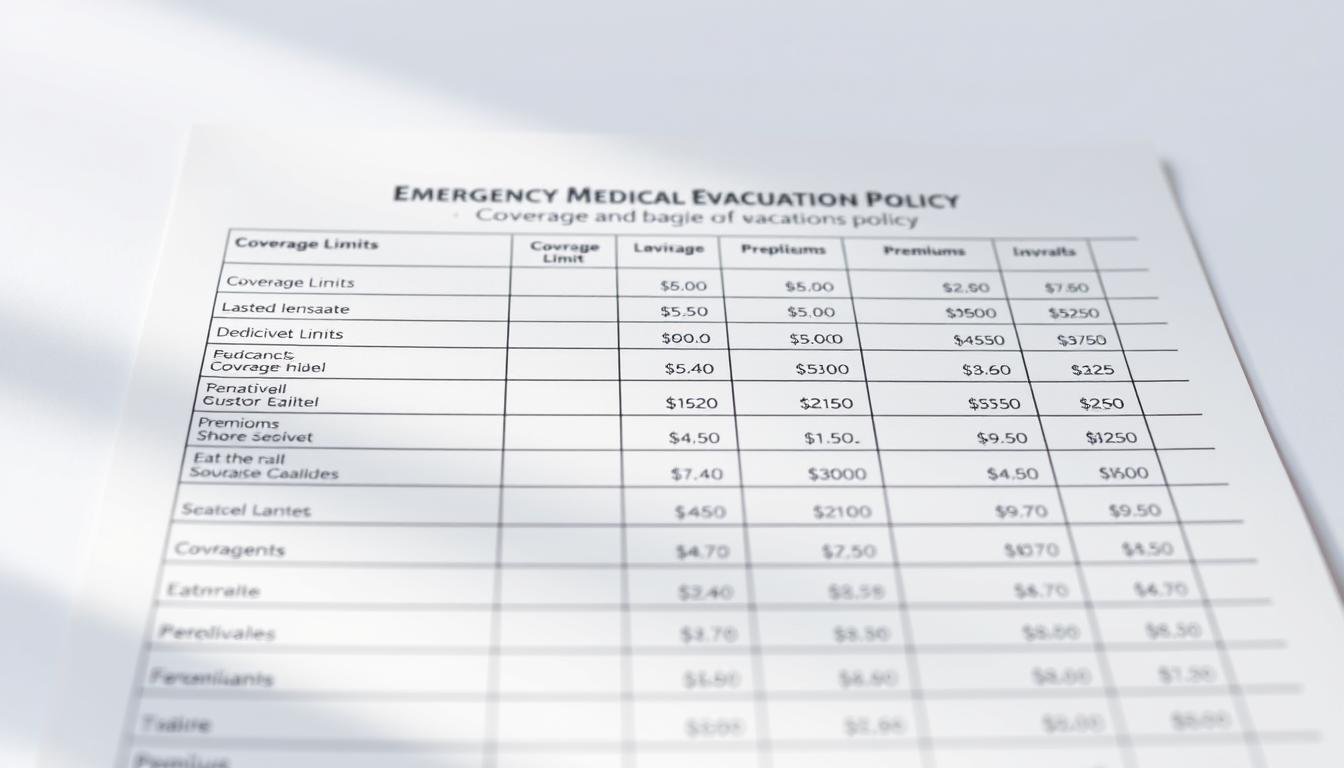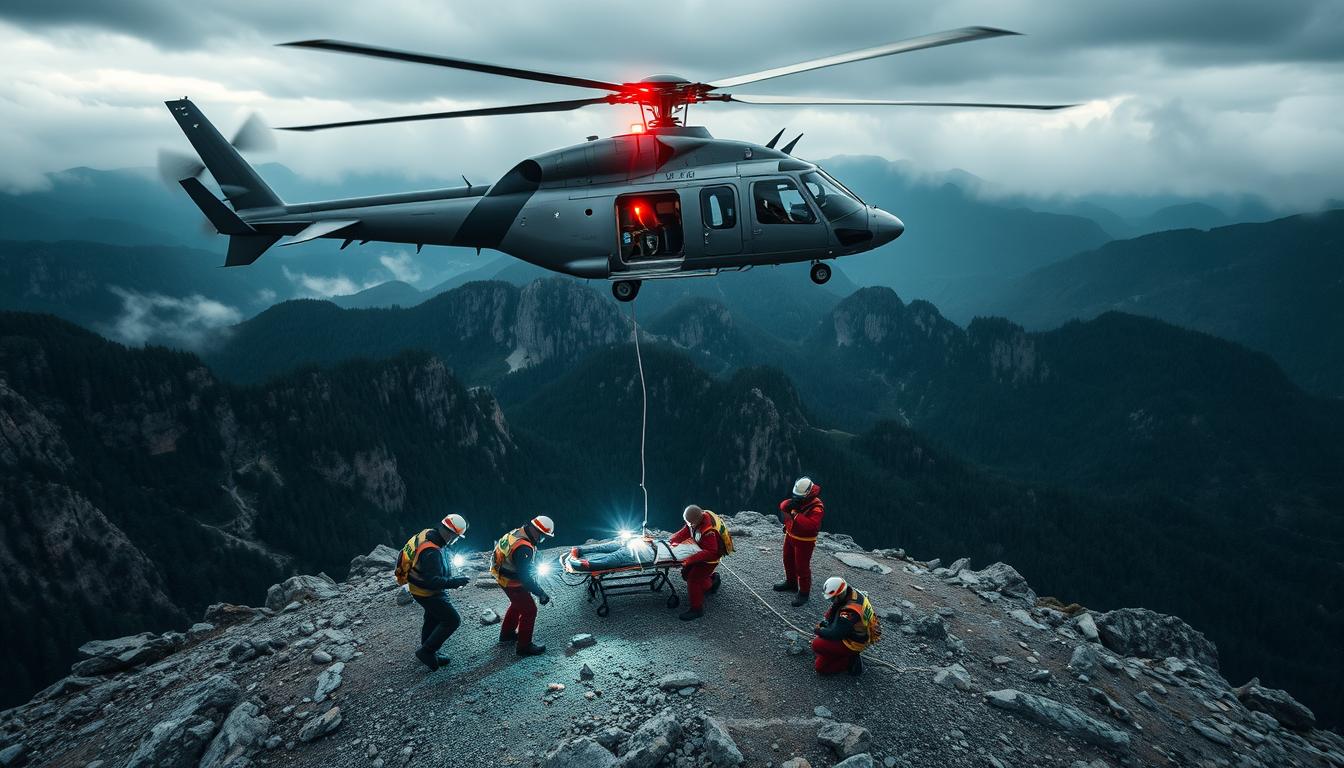Imagine needing urgent care far from home, only to realize getting proper treatment requires a helicopter or private jet. This scenario isn’t just dramatic—it’s a real concern for travelers. Understanding evacuation coverage could mean the difference between financial strain and peace of mind during a crisis.
Most comprehensive travel plans include basic medical transport benefits. But here’s the catch: standard policies often cap costs or exclude remote locations. Specialized coverage fills these gaps, ensuring you reach quality facilities without draining savings.
Industry reports show airlifts can exceed $200,000—a bill few can shoulder alone. Whether it’s mountain rescues or ambulance transfers between hospitals, having the right protection matters. We’ll break down what typical plans offer versus advanced options so you can travel smarter.
Introduction to Emergency Medical Evacuation
Picture this: You’re hiking in Patagonia when a sudden injury leaves you stranded. Local clinics can’t provide advanced care, and arranging transport becomes your top priority. This is where specialized coverage steps in—covering everything from air ambulances to commercial flight home arrangements when local treatment isn’t enough.
What It Means for Travelers
Remote adventures often lack proper healthcare infrastructure. For example, Nepal’s Everest region has only basic clinics, while Alaska’s wilderness areas may require helicopter lifts. A robust insurance plan handles logistics and costs, letting you focus on recovery instead of bills.
| Scenario | Standard Coverage | Specialized Plan |
|---|---|---|
| Mountain rescue | Limited or excluded | Full airlift costs |
| Overseas hospital transfer | Up to $50,000 | Unlimited transport |
| Return flight with medical staff | Not included | Priority arrangements |
Why Timely Evacuation Can Save Lives
Every minute counts during critical health events. Data shows patients moved within 4 hours of diagnosis have 60% better recovery rates. Yet 1 in 3 travelers lacks adequate protection for such scenarios.
Consider a snorkeling accident in Bali: Quick transfer to Singapore’s advanced hospitals could prevent long-term complications. Your insurance plan ensures swift coordination, whether it’s a medevac jet or a flight home with oxygen support.
Understanding Emergency Medical Evacuation Insurance
Imagine being hours away from proper care during a health crisis. Specialized plans focus on moving you to a medical facility equipped to handle your condition. This type insurance covers airlifts, ground ambulances, and even chartered flights with trained staff.
Defining the Coverage
These plans prioritize getting you to quality care quickly. Key features include:
- Transport to the nearest appropriate medical facility
- Round-the-clock coordination with rescue teams
- Professional medical escort services during transit
Unlike basic policies, this insurance cover addresses complex logistics. It’s designed for scenarios where local clinics lack advanced equipment.
How It Differs from Other Travel Policies
Standard comprehensive travel plans often stop at hospital bills or lost luggage. Compare two approaches:
| Feature | Typical Plan | Specialized Plan |
|---|---|---|
| Remote area rescue | Partial coverage | Full coordination |
| Medical staff during transport | Rarely included | Standard service |
| Facility quality standards | Local options | Internationally accredited |
The right insurance cover bridges gaps between “available” and “adequate” care. For adventure travelers or those visiting rural areas, this type insurance becomes essential protection.
Key Components of Medical Evacuation Coverage
Getting stranded without adequate care is a traveler’s nightmare scenario. Quality protection focuses on two critical elements: moving you to facilities that can actually help and ensuring you’re supported throughout the journey. Let’s unpack what this looks like in real-world situations.
Transportation to Adequate Medical Facilities
When local clinics can’t provide necessary care, specialized plans activate. They coordinate ground ambulances, helicopter lifts, or even chartered flights to reach hospitals meeting strict quality standards. For example, a hiker with a broken leg in Peru’s Andes might need a helicopter transfer to Lima—a service that could cover costs exceeding $25,000.
Policies typically include:
- 24/7 coordination with rescue teams
- Approval for air or ground emergency transportation
- Direct billing with service providers
Role of Medical Escorts and Companions
A trained medical professional often accompanies patients during transfers. They monitor vital signs, administer medications, and communicate with receiving facilities. Some plans also allow a family member to join the transport—crucial for emotional support during stressful situations.
“Back home” benefits take effect when doctors recommend continued care in your country. This might involve flying you on a commercial flight with medical staff or arranging a private jet equipped with ICU capabilities. These services ensure you recover surrounded by familiar faces without draining savings.
Coverage Limits and Cost Considerations
Did you know air ambulance rides can cost more than a luxury car? Understanding your plan’s financial safeguards helps avoid surprise bills. Policies vary widely—some cap transport expenses at $100,000, while premium options reach $1 million to handle complex rescues.

Understanding Policy Coverage Amounts
Basic plans often fall short in remote areas. For example, rescues in Nepal’s Himalayas might require $250,000 for helicopter teams and international transfers. High-tier policies cover these scenarios through:
- Unlimited transport to quality facilities
- 24/7 coordination with rescue specialists
- Direct payments to service providers
| Coverage Tier | Maximum Benefit | Key Features |
|---|---|---|
| Basic | $100,000 | Local ground transport only |
| Mid-Range | $500,000 | Regional airlifts included |
| Premium | $1,000,000 | Global private jet evacuations |
Analyzing Expenses in High-Risk Scenarios
Transport type dramatically impacts costs. Helicopter rescues average $25,000 per hour, while commercial flights with medical staff cost $10,000–$50,000. Alaska’s wilderness or Amazon rainforest trips often require pricier solutions.
Without proper protection, you might pay $150,000+ out-of-pocket for a single emergency. Look for plans specifying:
- No distance restrictions
- Guaranteed facility quality
- Family travel companion allowances
How Emergency Medical Evacuation Insurance Works
When a health scare strikes mid-trip, knowing your protection plan’s roadmap can turn chaos into clarity. Assistance teams become your lifeline, coordinating every detail to get you safe care fast.
The Process During a Medical Crisis
Here’s what happens after you contact your provider:
- Immediate assessment: Teams connect with local doctors to review your condition.
- Transport decisions: They determine if moving you is safer than local treatment.
- Logistics activation: Flights or ambulances get booked based on urgency and location.
For example, a broken leg in Costa Rica’s jungle might require helicopter pickup to San José. Your team handles permits, weather checks, and hospital confirmations while you focus on recovery.
What to Expect from Emergency Assistance Teams
These experts work like travel guardians. They’ll:
- Communicate updates to family back home
- Arrange commercial flight upgrades for medical equipment space
- Secure ground transport at both departure and arrival points
Document everything—take photos of injuries, save receipts, and note provider names. This paperwork speeds up claims later. Knowing these steps cuts stress and ensures you receive timely care when minutes matter most.
Inclusions and Exclusions in Your Policy
Your safety net abroad depends on knowing exactly what your plan covers—and what it doesn’t. Most policies shine in urgent scenarios but leave gaps you’ll want to spot early. Let’s unpack the essentials so you’re never caught off guard.
Commonly Covered Benefits
Quality plans typically handle these critical services:
- Returning home if local care can’t treat your injury
- Dedicated medical staff during transport
- 24/7 coordination with rescue teams
For instance, if you break a leg while hiking, your plan might cover helicopter transport to a hospital and a flight home with a nurse. These services prevent you from footing five-figure bills alone.
Key Limitations and Exclusions to Note
Watch for these common coverage gaps:
- Injuries from skydiving or mountaineering
- Pre-existing health conditions
- Non-urgent transfers between facilities
Some plans require using specific hospitals or deny claims if you ignored travel advisories. A friend learned this the hard way when her Bali scooter accident wasn’t covered due to local safety warnings.
Always check:
- Facility quality standards in your policy
- Activity restrictions before booking adventures
- Time limits for reporting injuries
Understanding these details ensures your care stays affordable and effective when surprises strike.
Buying and Utilizing Your Insurance Plan
Your next trip deserves protection that matches your adventure spirit. Start by reviewing existing benefits—many premium credit cards include basic transport services. But don’t stop there. Compare options to find coverage that aligns with your destinations and activities.
Steps to Purchase or Upgrade Your Plan
Follow this checklist to secure reliable protection:
- Audit current benefits: Call your credit card issuer to confirm ambulance coverage limits and facility standards
- Compare stand-alone policies: Use comparison tools like Squaremouth to evaluate companion allowances and claim processes
- Verify activity coverage: Ensure your policy covers transport from remote hiking trails or cruise ship ports
| Feature | Credit Card Plan | Stand-Alone Policy |
|---|---|---|
| Ambulance coverage | Up to $50,000 | Unlimited |
| Companion travel | Not included | 1 family member |
| Facility standards | Local hospitals | International networks |
Tips for Using Your Policy When It Matters Most
Save your provider’s 24/7 hotline in your phone contacts. If an incident occurs:
- Contact assistance teams before arranging transport yourself
- Document interactions with local medical staff
- Keep receipts for any upfront payments
Remember—understanding your benefit details prevents claim denials. Ask providers specific questions about ambulance service areas and companion eligibility during your research phase.
Coverage During Domestic and International Travel
What happens if you need urgent care while road-tripping through Montana or trekking in Thailand? Your location dramatically impacts how your protection plan responds. Policies adapt based on whether you’re hours from a doctor or continents away from home.
Special Considerations for U.S. Travel
Domestic plans often assume shorter distances to quality care. But rural areas like Alaska or Wyoming might require air transport. Some policies impose waiting days before approving transfers—always check this detail.
Key factors for U.S. trips:
- Proximity to trauma centers
- Ground ambulance vs. helicopter costs
- Pre-approval processes for non-local hospitals
Navigating International Medical Evacuation Needs
Overseas trips add layers of complexity. Repatriation—returning you home—becomes critical if local facilities can’t provide long-term care. One traveler’s story highlights this: After a bike accident in Greece, their family member coordinated with assistance teams to arrange a medically equipped flight back to Chicago.
Three steps for international travelers:
- Confirm repatriation benefit limits with your provider
- Share trip details with a trusted family member
- Ask your doctor about destination-specific health risks
| Consideration | Domestic | International |
|---|---|---|
| Average response time | 4-8 hours | 12-24 hours |
| Common transport | Ground ambulance | Chartered flights |
| Family involvement | Optional updates | Required approvals |
Always discuss location-specific risks with your doctor and provider. Adventure to remote islands? Verify if your plan covers boat-to-air transfers. Urban destinations? Check hospital network partnerships. Smart prep lets you explore confidently, knowing you’re covered from Yellowstone to Yemen.
Conclusion
Travel opens doors to new experiences, but unexpected challenges can arise. Choosing the right protection means understanding your plan’s terms—like how medical escorts ensure safe transport or when repatriation becomes necessary. A quick policy review with a physician or trusted friend could reveal coverage gaps before your trip.
Key takeaways? Always verify transport limits and facility standards. Confirm whether your plan covers specialists who accompany you during transfers. These details matter when minutes count.
Compare options tailored to your adventures—whether that’s beach vacations or mountain treks. Many providers offer customizable features, from escort services to family notifications. Consult experts to match your needs with the right solution.
Smart preparation isn’t about expecting the worst—it’s about enjoying journeys knowing you’re protected. With clear terms and reliable support, every traveler can embrace discovery while staying grounded in safety.


